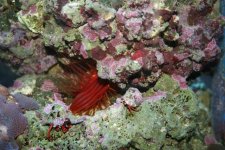Look at this article http://www.reefkeeping.com/issues/2002-03/rs/index.php (The Infamous Detritivore by Ron Shimek) and
http://www.reefkeeping.com/issues/2003-06/rs/feature/index.php (How Sand Bed Really Works by Ron Shimek) and http://www.reefkeeping.com/issues/2004-12/rs/index.php (Echinoderms in Aquaria by Ron Shimek)
Obviously, sea stars are neat and amazing animals. Just as obviously, most are simply not suitable for marine aquaria. They eat a lot, and some eat everything they encounter. In tropical areas, many of the most common stars feed on corals, which really isn’t surprising, as there is a lot of this food and it cannot run away. In addition to Acanthaster, other species, such as Choriaster granulatus and Culcita novaeguinea, share the coral diets. The genus Linkia, however, is reef safe. The large, blue Linkia laevigata, occasionally found for sale, is a surface deposit feeder and a relatively good scavenger. However, they can get quite large, well over a foot (30 centimeters) in diameter and can outgrow an average aquarium. Some smaller species of Linkia, such as Linkia multiflora, are very attractive animals that may make a good addition to aquaria. The linkiids also have another interesting trait. They reproduce by “cometary fission,” in which one arm and a portion of the central disk rips off the parent (which then heals up and grows a new arm). The arm walks away and regenerates a disk and more arms from the disk. These regenerating stars look a lot like Mediaeval drawings of a comet — hence the name “cometary” reproduction. As with all echinoderms, linkiids do best at full strength reef salinities of 35 to 37 ppt and temperatures around 84 degrees Fahrenheit.
Rossana
http://www.reefkeeping.com/issues/2003-06/rs/feature/index.php (How Sand Bed Really Works by Ron Shimek) and http://www.reefkeeping.com/issues/2004-12/rs/index.php (Echinoderms in Aquaria by Ron Shimek)
Obviously, sea stars are neat and amazing animals. Just as obviously, most are simply not suitable for marine aquaria. They eat a lot, and some eat everything they encounter. In tropical areas, many of the most common stars feed on corals, which really isn’t surprising, as there is a lot of this food and it cannot run away. In addition to Acanthaster, other species, such as Choriaster granulatus and Culcita novaeguinea, share the coral diets. The genus Linkia, however, is reef safe. The large, blue Linkia laevigata, occasionally found for sale, is a surface deposit feeder and a relatively good scavenger. However, they can get quite large, well over a foot (30 centimeters) in diameter and can outgrow an average aquarium. Some smaller species of Linkia, such as Linkia multiflora, are very attractive animals that may make a good addition to aquaria. The linkiids also have another interesting trait. They reproduce by “cometary fission,” in which one arm and a portion of the central disk rips off the parent (which then heals up and grows a new arm). The arm walks away and regenerates a disk and more arms from the disk. These regenerating stars look a lot like Mediaeval drawings of a comet — hence the name “cometary” reproduction. As with all echinoderms, linkiids do best at full strength reef salinities of 35 to 37 ppt and temperatures around 84 degrees Fahrenheit.
Rossana
Last edited:
























